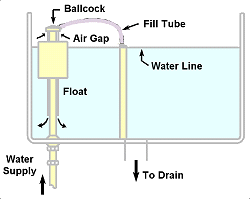Backflow Prevention
Cross-Connection Program
MCWS works hard to ensure that the water we bring to your home is the safest, purest available. That is why we are constantly on the alert for any situation that would degrade that purity. Our cross-connection prevention program is one way that our staff ensures that the water you and your family drink is always the best. We believe, however, that every water customer should know about cross-connections. A cross-connection is any pipe, valve, fixture, etc. in a drinking water plumbing system that may allow the drinking water within the system to become contaminated or questionable in quality. Even a lawn sprinkler system can be a potential source for contamination. Cross-connections can be eliminated or protected by an air gap or mechanical backflow prevention. Please contact our office for additional information.
Clean, safe drinking water is something we take for granted, but every home may have potential hazards which threaten to contaminate our drinking water. Ensuring our water is safe is everyone’s responsibility.
THE PROBLEM
Cross-Connection - What is a cross-connection? A cross-connection is any physical arrangement whereby public water supply is connected, directly or indirectly, either inside or outside of a building, with any other water supply whether public or private, sewer, drain, conduit, pool, storage reservoir, plumbing fixture or other device which contains or may contain contaminated water, sewage or other waste, liquid, gas or solid, of -unknown or unsafe quality which may be capable of contaminating the public water supply as a result of back flow caused by the manipulation of valves, because of ineffective check valves or back pressure valves, or because of any other arrangement.
Back Siphonage - Most household cross connections are created by hoses. Under certain conditions, the flow in household water lines can reverse and siphon contaminants into the water supply. For example, using a garden hose to spray pesticides or fertilizers is normally harmless, but if the city’s water supply is interrupted while you are spraying, you may have a problem. If water main pressure is reduced due to a water main break or nearby fire fighting, a back siphonage effect is created. This can draw water from your garden hose into your home water supply. So if you have pesticide or fertilizer sprayer attached to your garden hose, the chemicals can contaminate your water supply.
Backpressure - Backpressure may cause backflow to occur where a potable water system is connected to a nonpotable system of piping, and the pressure in the nonpotable system exceeds that in the potable system. High pressure may be created by means of pumps, boilers, etc. There is a high risk of non-potable water being forced into the potable water system whenever backpressure conditions exist.
Solution 1 : Air Gaps - An Air Gap is a physical separation of the supply pipe by at least two pipe diameters (never less than one inch) vertically above the overflow rim of the receiving vessel. In this case, line pressure is lost. Therefore, a booster pump is usually needed downstream, unless the flow of the water by gravity is sufficient for the water use. With an air gap, there is no direct connection between the supply main and the equipment. An air gap may be used to protect against a contaminant or a pollutant, and will protect against both backsiphonage and backpressure. An air gap is the only acceptable means of protecting against lethal hazards. Never leave a hose where it can suck contaminants back into the drinking water supply, such as in a swimming pool, bathtub, sink or fish tank.
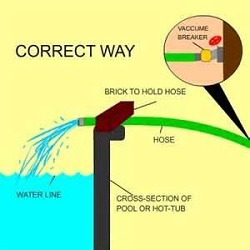
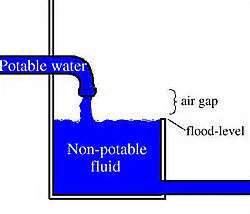
Solution 2 : Hose Connection Vacuum Breakers - You can also prevent back siphonage by using an inexpensive, easy-to-install hose connection vacuum breaker. This one-way valve allows water to flow from the tap, but not back in. (Drainable vacuum breakers should be installed on all taps which could freeze.)
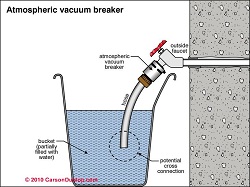
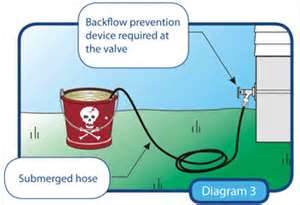
Solution 3 : Anti-siphon Ballcocks - For example, toilet tanks contain a ballcock device which allows water into the tank after flushing. Older style ballcocks do not have an anti-siphon feature and can allow water from the toilet tank to backflow into your drinking water line. (fig. 1) A simple anti-siphon ballcock (fig. 2) installed with a 25mm (1”) air gap above the overflow tube will prevent contaminated tank water from entering your water supply.
|
|
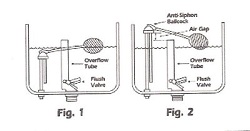 |
Solution 4 : Reduced Pressure Backflow Preventer Device is used to protect the water supply from contamination. They may also be known as reduced pressure principle backflow prevention devices, reduced pressure zone assemblies.
High hazard applications are suitable for the utilization of the reduced pressure backflow preventer, that is, where the consequence of backflow into the water supply would cause significant harm. They are considered suitable because they prevent both backflow and backsiphonage, because of a redundant design (even with two check valves broken the device still provides protection), and because they are testable to verify correct operation.
Safe Drinking Water is Everyone's Responsibility
Federal and provincial governments are responsible for setting high standards for water quality.
Maury County Water System is responsible for producing and supplying drinking water which meets or exceeds these standards.
Homeowners are responsible for ensuring that drinking water does not become contaminated as a result of a cross connection. Remember, you are not only protecting your own water supply, but your neighbors’ as well.
Swimming Pools
Underground Sprinklers for lawns
Automatic Water for livestock tanks
Hot Water Boilers
All of the above can be extremely hazardous.
For more information, please contact our office.



